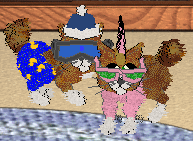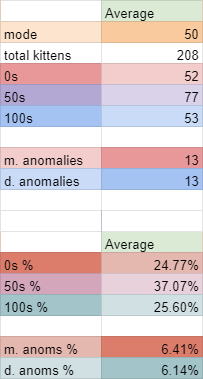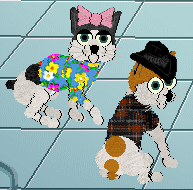PERSONALITY INHERITANCE
A pet's individual personality values are separate from its personality genes.
Its individual values dicate only how it behaves, and has no effect on how its offspring behaves. Equally, its genes dictate only what genes its offspring inherit, and has no effect on how it itself behaves.
Each pet has two of every gene: Set1 genes, inherited from its mother, and Set2 genes, inherited from its father. Gen1 petz do not have parents, so their genetic sets are identical and match whatever their individual values are.
When two petz breed, they both give one gene of each type to their offspring, randomly choosing between set1 and set2 genes for each value. A litter will always inherit exact copies of the given genes.
Interestingly, a litter always shares which genes are inherited. If one kitten is given the mother's set2 Insanity gene, then all the kittens in that litter inherit said set2 gene. This may also apply to physical genes, but more research is needed.
However, a pet's individual values do not always match what their genes suggest they should be.
Index
Mutations and Anomalies
Random Generation of Individual Values
Gene Editing of Unborn Kittens
Mutations and Anomalies
The genes a pet inherits doesn't necessarily dictate its individual values, petz have the chance to mutate new values while keeping the same genes.
A pet's offspring can be sorted into one of five categories, per specific value:
- mother clone / m. clone
- mother-biased anomaly / m. anomaly
- midpoint
- father-biased anomaly / d. anomaly
- father clone / d. clone
(I chose 'd' to represent father, as it's too easy to confuse m/f for male and female.)
A 'cloned' value is the exact value of a given gene. For instance, if a kitten inherited an Insanity 100 gene from its mother and its individual Insanity value is also 100 - then it is an m. clone for that specific trait.
A 'midpoint' value is the exact middle of the two inherited genes, and will also be referred to as anomalous. For instance, if a kitten inherited a Kindness 50 gene and a Kindness 70 gene, the midpoint value would be Kindness 60. Note that the midpoint is always rounded down.
An 'anomaly' is a rarer occurrence, where a kitten has cloned neither of its parents nor taken the midpoint. Instead, it has a random value between its two inherited genes. For instance, an anomaly between the previous example's genes could be Kindness 52, or Kindness 65, et cetera.
Anomalies are categorised as biased towards one parent or the other. If it falls between the mother's value and the midpoint, it is an m. anomaly, and vice versa. There is not currently enough data to know if there is a pattern towards what bias a given gene's anomalies may take, it may just be entirely random.

To help explain this system, I have modified the genes of two Maine Coon catz: Nil (the mother), whose personality genes have all been hexed to 0, and Many (the father), whose personality genes have all been hexed to 100. Note that their OffspringSex values were left at 50 for testing.

These are all the possible ranges for Nil and Many's litters. Note all four variations are the same, as the parents' set1 and set2 genes are identical.
Of their 208 kittens, as of writing, all of them inherited one 0 gene and one 100 gene for every personality values, but their individual values wildly varied at times.

The most common individual value for all traits combined was 50 (the midpoint), however the most likely value was a clone of either parent (either 0 or 100). Anomalies, on the other hand, were much rarer.
More kitten data needs to be added for these values to hold any real significance, but currently the rough odds of each category are:
- either parent clone: 51%
- midpoint: 37%
- any anomaly: 12%
Anomalous petz will not pass their anomalies down to their offspring, as only their individual values are affected, their genes remain exact copies of their parents' given genes. If this applies to physical genes as well, it would explain why mutie petz do not reliably produce mutie litters.

To properly test the interaction between anomalies and set1/set2 genes, I have hexed a second set of parents, both Japanese Bobtails: 030 (the mother), whose personality genes have all been hexed to 0/30, and 60100 (the father), whose personality genes have all been hexed to 60/100.
This study is currently in progress, the needed kittens are still being bred. I will update this section when it's done! More kittens will also be added to the Nil/Many study, and a zip file of all the kittens will be available for download when a sufficient amount of kittens is reached.
A second 0/100 pair will also be studied, to see if the apparent biases towards one parent or the other remains consistent. There may be 'gene weights' that can also be passed down, to simulate dominant or recessive genes, but that is just speculation, no relevant values have been found so far.
Random Generation of Individual Values
A pet's individual values are randomly generated upon birth, based on the genes it has inherited. This means that if you clone a pregnant pet, both litters will have different personalities, despite inheriting the same genes each time.
Offspring sex is also generated on birth, using the two OffspringSex genes it inherited from its parents. Usually, all petz' OffspringSex value is always 50, for a 50% chance of either sex. How offspring sex generates with two different OffspringSex genes still requires research.
An exception to this is physical appearance, which is stored per kitten in the mother file's pre-YALP section. This means that if you clone a pregnant pet, its litter will always look the same. If the third kitten is a blue-eyed mutie it will always be a blue-eyed mutie.
The physical genes of unborn kittens are still being researched, however a litter of four almost doubles the file size of the mother's file, so there is a lot to sift through.
Gene Editing of Unborn Kittens
Normally, petz have two y-bands under its YALP. When a pet becomes pregnant, it gains two extra y-bands for a total of four.
The first two y-bands contain the adult pet's genetic information. Once a pet is already pregnant, changing these values will not affect any offspring it is carrying.
The next two y-bands contain the genetic information for the entire litter, the first band containing the litter's set1 genes and the second band containing their set2 genes.
Note that physical gene data is not stored in the y-bands, instead it is stored between the pre-YALP p f magic and YALP. This section requires more research, but it is known that each kitten's data is stored separately, and is fixed upon birth.
As each litter shares its y-band genetic information, this means you cannot edit the personality values for individual kittens, any changes made will affect all of them. If you want to only modify one kitten's individual personality, you will have to wait until it is born.














 --> Personality Inheritance
--> Personality Inheritance